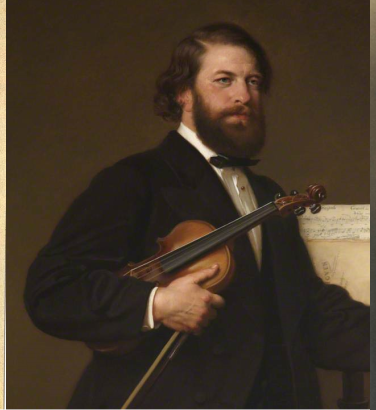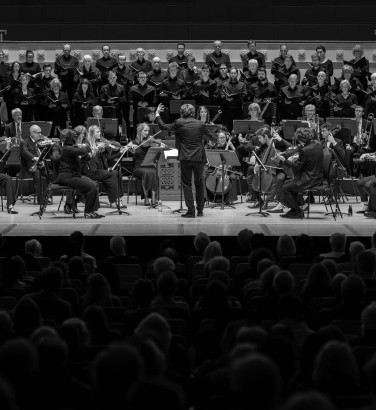
The story behind Silent Night and other carols
18 Nov 2024
News Story
Photo credit: Jen Owens
Carols have possibly the richest heritage of all the traditional elements of Christmas celebrations in the English-speaking world. They can be sacred or secular (some even blur the boundaries), and a good deal of them have a history going back several centuries, in some cases having come from outwith these isles. The fact this applies just as much to their music as their words only serves to emphasise the sheer variety in their origins. This article can only provide a snapshot of them, but we hope that it may serve to whet your appetite for the festive season!
We should perhaps start, however, by acknowledging that the carol was not always specifically associated with Christmas. Shakespeare’s song ‘It was a lover and his lass’ (from As you like it), for instance, is set in springtime, yet includes the line ‘the carol they began that hour’, and a small number of Easter carols remain in use today. This joyful Eastertide, probably the best-known of these, is actually a comparatively recent addition to the repertoire: its words are dated 1894, sung to a 17th century Dutch tune.
This combination of poetry and music from different cultures is not even particularly unusual. Angels from the realms of glory was written in 1816 by the Scottish poet James Montgomery and (in Britain) is now sung to a French tune of uncertain origin, but published in 1842. In dulci jubilo is supposed to have come from even further afield: according to folk legend, it was brought to us by none other than the angels, who sang it to the 14th-century German mystic Heinrich Seuse. It is also among a small number of carols with multilingual text, the technical term for this being macaronic. Orff’s Carmina Burana provides the best-known example of this, its text being by turns in Latin, medieval German and French, but several carols also qualify, including Ding! dong! merrily on high, Gabriel’s Message (also known by its first line, ‘The angel Gabriel from Heaven came’) and the lesser-known Boar’s Head Carol.
The last of these also serves as a prime illustration of the secular tradition of carols. The text has no connection to Christianity, referencing an ancient Anglo-Saxon ritual believed to bring luck as the new year got underway. Deck the halls, on the other hand, gives the impression of being very old – its ‘fa la la la la’ refrain could from straight from a Tudor madrigal – but the tune didn't appear until the 16th century, with the words (by another Scot, Thomas Oliphant) following in 1862. Carol of the Bells, a fixture of the season for anyone familiar with the 1990 film Home Alone, also sounds older than it is, probably because is based on traditional Ukrainian folk music. Written in 1914 by one Mykola Leontovych as a song for the New Year, it only became associated with Christmas when it gained new (English language) lyrics in 1936. The previous year had witnessed the first known performance of We Wish You a Merry Christmas outside the West Country; however much the line ‘now bring us some figgy pudding’ may suggest far older festive traditions, its earlier history is much debated.
There was a boy singing a Christmas Carol at my door last night. I should like to have given him something; that's all.
The inclusion of a geographical location in the title of a carol is generally a good indication of its age, at least as far as English repertoire goes. The Coventry Carol – which, in telling of the Massacre of the Innocents, may have the most dispiriting of any carol text – is known from performances in that city at least as far back as the 16th century, and gained a rather chilling relevance when performed in the ruins of its medieval cathedral at the end of a BBC broadcast on Christmas Day 1940, a mere six weeks after Coventry had been heavily bombed during the Second World War. The Gloucestershire Wassail and Sussex Carol are both known to us thanks to Vaughan Williams, who came across them them as part of his research into English folk music in the early 20th century, though versions of the former had been published during the 1800s.
The mid-19th century revival of Christmas as a popular festival happily coincided with the creation of one of the Christmas carols: Hark! the herald angels sing. The words had first appeared in 1739, but had to wait until 1855 before they were successfully paired with the music associated with them ever since. Adapted from Mendelssohn’s 1840 Festgesang, written to commemorate Gutenberg’s invention of printing with movable type four centuries previously, it has become a mainstay of the season, not least as one of the final hymns in carol services across the English-speaking world. The other contender is O come, all ye faithful, which dates at least as far back as 1751, when it was first published by one John Wade. The authorship of both text and music are heavily disputed: Wade himself is a contender for both, in the case of the former with an extra dimension thanks to his political leanings. It has been claimed that Adeste fideles is in fact a coded message in support of Bonnie Prince Charlie’s claim to the British throne: the words ‘regem angelorum’ in the first verse (generally translated as ‘born the King of Angels’) are supposed, in this context, to be a pun on ‘regem anglorum’ (‘king of the English’), but the theory as a whole seems a little tenuous.
If anything, it’s quite refreshing that Silent Night – a new arrangement of which gives its name to this year’s SCO Chorus Christmas concert (18 – 19 December) – is an older carol whose history, long suspected of being hearsay, was proven correct many years after the event. As stories go, it seems a bit too good to be true: on Christmas Eve 1818, a priest in a parish 12 miles north of Salzburg found himself with an inoperable organ after flooding from the nearby river, and asked one Franz Xaver Gruber, a local schoolteacher and organist, to compose a setting of some words he had written for two voices and guitar. The carol was performed that very evening and its popularity gradually spread, with performances at the Leipzig Gewandhaus in 1832 and in New York in 1839. Although Silent Night was the centre of the 1914 Christmas truce along the World War One trenches and given a particularly memorable rendition by Bing Crosby in 1934, its history slowly passed into legend. It got to the point where Gruber was begrudgingly recognised as the carol's composer – it wasn’t uncommon for the music to be attributed to the much more celebrated Mozart or Schubert, clearly with a hefty dose of wishful thinking – but the priest’s name was long since forgotten.
Then, in 1995, the manuscript below came to light:

Besides the carol itself, there are two important pieces of text here. The first (top right) identifies Gruber as its composer, but even more significant are the words 'Text von Joseph Mohr mpia Coadjutor 1816' in the opposite corner: 'text by Joseph Mohr, confirmed by my own signature, assistant priest 1816'. After further research, it was estimated that this manuscript was written between 1820 and 1825, providing us not only with the earliest known handwritten copy of Silent Night, but the only one in Mohr's own hand. After over a century of conjecture about this beloved carol's origins, the last piece of the jigsaw was finally in place.
Let us finish with a little treat by way of Silent Night as arranged by Charles Mackerras, a much-missed member of the SCO family. He recorded it in 1957 (with Elizabeth Schwarzkopf, no less), restoring most of the original tune - the penultimate line of each verse may sound unfamiliar - and, in retaining its guitar accompaniment, the sense of intimacy that characterised Gruber's composition.
On which note, a very merry Christmas from all of us at the SCO!
Related Stories
![A violinist shown at three different ages: as a young man in a drawing, middle-aged in a painting and elderly in an old photo]()
Joseph Joachim and the great German violin concertos
7 April 2025
Beethoven, Mendelssohn, Bruch and Brahms: four violin concertos, all connected by a single violinist.![Three men, the first two in 18th century formal dress (one in black and white, one in a red coat), the last in an old photo, smoking]()
What is a sinfonia concertante?
17 March 2025
We delve into the history of a hybrid genre ...![]()
The SCO Chorus on music for Lent
10 March 2025
With Easter just around the corner, we delve into perhaps the richest (and often darkest) choral repertoire of all ...


